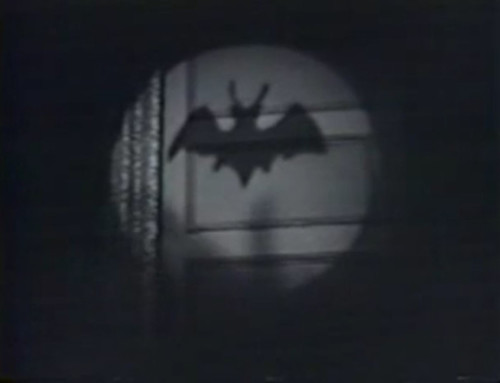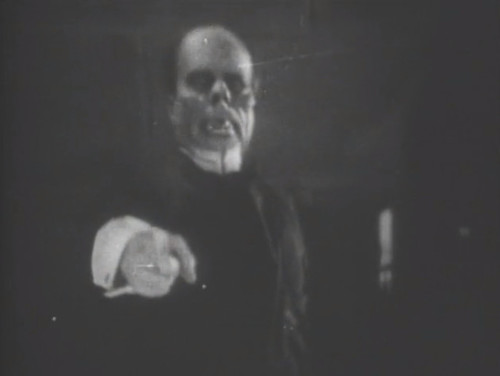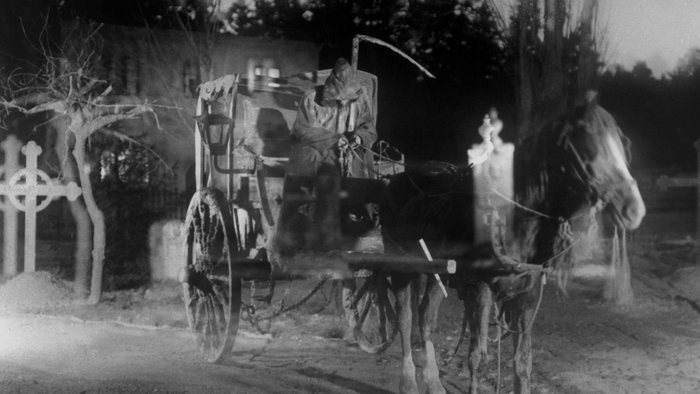The weather is turning, wind is blowing through leaf piles, wicker baskets are filled with mutant squash, people are mutilating pumpkins for fun, yards are filling up with cemetery furnishings like tombstones with ironic inscriptions, decorative corpses, and ornamental cobwebs, and of course, the pumpkin spice must flow. These and other nominally ghastly traditions suddenly becoming socially acceptable can mean only one thing: It’s Halloweentime! Yes, it’s the best time of the year, and to celebrate, we here at Kaedrin watch a crapton of horror movies over the course of the next six weeks. Why six weeks? Well, it used to be a lot better than most normal people’s four week marathons… but now everyone else seems to have caught on and started in with the Halloween jam starting in September. These days, Pumpkin beer shows up in July. Not that I’m complaining (I mean, the start of summer is at least partly great because by then we’re well on our way to Halloween).
This year’s marathon starts off with a trio of silent horror movies. I tend to find these movies a tad staid, but it’s always an interesting experience and often illustrates a direct line of influence to current horror trends. The excessive focus on visuals over all can also lead to indelible imagery that can’t quite be replicated by sound films (not that they don’t have their own visual impressiveness, it’s just different). Don’t worry, we’ve got plenty of time to descend into the more schlocky gore and so-bad-it’s-good zaniness. But for now, let’s strap on our monacle and observe some historically important cinema!
- Don’t (fake trailer)
- The Simpsons: Treehouse of Horror: Bad Dream House
- The Cabin in the Woods (trailer)
- The Bat – A violent criminal dressed up like a giant bat terrorizes a family renting an old mansion in search of a banker’s hidden loot. Or something like that. Despite mostly taking place in one location, the plot is sometimes a bit hard to follow. Adapted from a play (which was itself adapted from a book), it’s clear that the silent era constraints on this one were insurmountable (director Roland West would later remake the film as a talkie in 1930; apparently a more refined take, and there’s also a 1959 remake starring none other than Vincent Price). That being said, there’s a lot of interesting stuff going on here. The transfer I watched wasn’t great quality, but the visuals were well done and memorable. It doesn’t quite capture the the extreme angular German expressionism of the era (typified by The Cabinet of Dr. Caligari), but some of those elements are well represented nonetheless. The intertitles (while perhaps not up to the task of encapsulating the plot) are mostly on point and even quotable (the winner:”For twenty years I’ve stood by you through Socialism, Theosophism and Rheumatism – but I draw the line at Spookism!”) It’s an early example of the “old dark house” tale (though The Cat and the Canary did it better just a year later), complete with all the requisite tropes: dark shadows, silhouettes, mistaken identities, hidden passageways, red herrings galore, a screaming, slapstick maidservant, a racist portrayal of a Japanese manservant, a sassy, drunken aunt, and a dude running around in some sort of elaborate costume. In this case a bat, which apparently was one of the inspirations for Batman (indeed, there’s even a sequence with a bat-signal).
At first shrouded in shadow and silhouette, The Bat is great looking, and even once you get a closeup look of the costume, it’s pretty neat. It’s also something of a precursor to the slasher and its various influences (i.e. Giallos, Krimis, etc…) The visuals do create a nice atmosphere, but it’s not especially scary. Some of the humor works well enough, but it’s also quite broad and sometimes incongruous with the generally dark tone (I kinda loved the whole bear trap gag though). All of which is to say that, while interesting, there’s not much here that hasn’t been done better elsewhere, even if this may have done some things first. Worth it for students of cinema to see how it influenced later works, it’s not really a movie for the normals. Still, I got a kick out of seeing all the tropes in their larval form. **
- The Phantom (Robot Chicken)
- The Phantom of the Opera’s Girl Problems (short)
- The Phantom of the Opera (1962) (trailer)
- The Phantom of the Opera – I’ve obviously seen the famous reveal from this film and countless imitations and remakes and parodies over the years, but this is the first time I’ve watched this one from start to finish. Set at the famous Paris Opera House, allegedly haunted by a Phantom who leaves notes making demands of the new owners about who should be performing what and when. The Phantom clearly has a thing for one of the ingénues and promises her fame and fortune, whilst sabotaging her competition. Watching this one made me realize that the pacing of The Bat was actually pretty good, as it’s much slower here. The shots are static and longer lasting, even the intertiles stay up on the screen for a beat or two longer (to my modern, continuous partial attention addled brain, it’s a bit much). On the other hand, the clarity of what’s going on is much better here, and of course there’s some all-time classic moments. Notably the aforementioned reveal of the Phantom without his mask, which really is something, even today.
I can’t imagine what the crowds of the day thought of this reveal, but it must have been wild. The film has a few other standout visuals as well. The Paris Opera House is lovingly captured here, and there is one sequence in which the Phantom dressed up in red at a sorta costume ball descends the staircase that is quite memorable (the Amazon Prime version I watched featured the red color, which really makes it stand out in the otherwise black and white film). The film has its baffling moments (apparently the result of studio meddling, which is not just a modern phenomenon) and while the story is simple and clear, it doesn’t entirely hold together on its own. But Lon Chaney’s performance keeps the entire affair humming. While menacing and mean-spirited, he sometimes manages to imbue the Phantom with a sadness that would be worthy of pity if he wasn’t constantly trying to kill people or kidnap women. His exaggerated physical movements and dramatic poses manage to imbue the film with a sense of dread that probably wouldn’t be present otherwise. If this were to come out today, I think it would be a boon to the the hot take industrial complex and movie twitter would be unbearable for a while. Or not. Whatever, it’s worth it for Chaney’s performance alone and could serve as a decent introduction to silent film. **1/2
- The Grimmest Reaper (Robot Chicken)
- The Chickening (short)
- Final Destination 2 (trailer)
- The Phantom Carriage – In Swedish folklore, there’s a legend that the last person to die on New Year’s Eve, if they’ve lead a wicked life, is doomed to drive a spectral carriage, collecting the souls of the dead for a whole year. This film opens with a Salvation Army nurse on her deathbed, asking for a local drunk she’d been working to reform. Said local drunk is hiding out in a cemetery. When he refuses to visit the ailing nurse, his friends beat him up and leave him for dead, whereupon the Phantom Carriage arrives. There’s a real Dickensian feel to the whole affair, as the drunk reflects on his life and bad decisions, and spoiler alert, what at first seems like it will be a really dark ending turns saccharine as the drunk repents and goes through a Scrooge-like transformation. It feels a bit rushed, I guess, but considering that this is a 1921 film, I’ll cut it some slack. The whole holiday redemption theme works well enough, and it’s got some great visual moments, including the spectral Phantom Carriage, which shows up translucent on screen and features the unsettling and now iconic image of the grim reaper, wearing a hooded robe and carrying a scythe.
This movie was Ingmar Bergman’s favorite film and clearly inspired his The Seventh Seal, amongst countless other films (notably including Stanley Kubrick’s The Shining, which directly homaged the shot of a man chopping through a wooden door with an axe). Really glad I caught up with this one, and the Criterion Collection presentation is great. ***
I must admit that I cheated a little by starting this year’s marathon early. I was away this weekend without access to the internets, etc… and I have another trip coming up that will probably cut down on the number of movies I watch this year (and I may skip a post or two). Otherwise, full bore til Halloween! Coming up: Tackling a current release and a trio of sequels to classics (that are, eh, not classics in themselves)…


